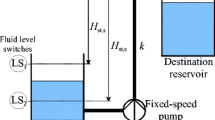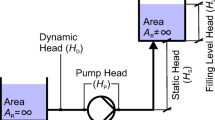Abstract
An effective way to save energy in pumping systems with low static head is to control the pump’s rotational speed with a variable-speed drive (VSD), which allows changing of the rotational speed when necessary. VSDs can be utilized to control batch transfer systems, for example, in filling or emptying a tank or a reservoir. In the literature, such processes have been optimized only with respect to energy consumption, but the time limit has been ignored. This means that pumping time can be very long. Our paper deals with this optimization problem and considers both pumping time and energy demand, which are often conflicting criteria. We derived a general optimal control law for rotational speed, which can easily be implemented in existing VSDs in the market. Minimum energy and minimum time schemes are special cases of this general new scheme. A constant flow rate scheme, suggested in the literature, is verified to give an optimum solution if the efficiency of the pump remains constant during operation. In addition to energy consumption, rotational speed control can have a favorable effect on the pump’s lifetime, as pointed out in the paper.










Similar content being viewed by others
References
Ahonen, T., Tamminen, J., Viholainen, J., & Koponen, J. (2014). Energy efficiency optimizing speed control method for reservoir pumping applications. Energy Efficiency. doi:10.1007/s12053-014-9282-6.
Bene, J. G., & Hős, C. J. (2012). Finding least-cost pump schedules for reservoir filling with a variable speed pump. Journal of Water Resources Planning and Management, 138(6), 682–686.
Bloch, H. P., & Budris, A. R. (2010). Pump user’s handbook: life extension (3rd ed.). Lilburn, GA: The Fairmont Press.
Budris, A. R. (2008). Hybrid control improves variable speed driven pump efficiency, reliability. Water World, 24(8), 11.
Casada, D. (1999). Energy and reliability considerations for variable speed driven pumps, In: Proceedings of 21st National Industrial Energy Technology Conference, May 12–13, 1999, Houston, Texas, USA.
da Costa Bortoni, E., de Almeida, R. A., & Viana, A. N. C. (2008). Optimization of parallel variable-speed-driven centrifugal pumps operation. Energy Efficiency, 1(3), 167–173.
de Almeida, A. T., Ferreira, F. J. T. E., & Both, D. (2005). Technical and economical considerations in the application of variable-speed drives with electric motor systems. IEEE Transactions on Industry Applications, 41(1), 188–199.
Gülich, J. F. (2003). Effect of Reynolds number and surface roughness on the efficiency of centrifugal pumps. Journal of Fluids Engineering, 125(4), 670–679.
Hovstadius, G., Tutterow, V., & Bolles, S. (2005). Getting it right, applying a systems approach to variable speed pumping. In: Proceedings of Energy Efficiency in Motor Driven Systems (EEMODS), September 5–8, 2005, Heidelberg, Germany.
Hydraulic Institute, Europump, & US Department of Energy’s Industrial Technologies Program. (2004). Variable speed pumping: a guide to successful applications. Oxford, UK: Elsevier.
Hydraulic Institute, Europump, & US Department of Energy’s Office of Industrial Technologies. (2001). Pump life cycle costs: a guide to LCC analysis for pumping systems. Parsippany, NJ: Hydraulic Institute.
Kallesøe, C. S., Skødt, J., & Eriksen, M. (2011). Optimal control in sewage applications. World Pumps, 2011(4), 20–23.
Karassik, I. J., Messina, J. P., Cooper, P., & Heald, C. C. (2008). Pump handbook (4th ed.). New York, NY: McGraw-Hill.
Lindstedt, M., & Karvinen, R. (2015). New control procedure for parallel pumping in reservoir pumping applications. In: Proceedings of 28th International Conference on Efficiency, Cost, Optimization, Simulation and Environmental Impact of Energy Systems (ECOS), June 29-July 3, 2015, Pau, France.
Mackay, R. C. (2004). The practical pumping handbook. Kidlington, UK: Elsevier Advanced Technology.
Schächtele, K., & Schneider, S. (2012). Energy efficiency in complex systems of the chemical industry. In: Proceedings of International Rotating Equipment Conference 2012 – Pumps and Compressors. September 27–28, 2012, Düsseldorf, Germany.
Smith, D. R. (1998). Variational methods in optimization. Mineola, NY: Dover Publications.
Tamminen, J., Viholainen, J., Ahonen, T., & Tolvanen J. (2013). Sensorless specific energy optimization of a variable-speed-driven pumping system. In: Proceedings of Energy Efficiency in Motor Driven Systems (EEMODS), October 28–30, 2013, Rio de Janeiro, Brasil.
Tamminen, J., Viholainen, J., Ahonen, T., Ahola, J., Hammo, J., & Vakkilainen, E. (2014). Comparison of model-based flow rate estimation methods in frequency-converter-driven pumps and fans. Energy Efficiency, 7(3), 493–505.
Ulanicki, B., Kahler, J., & Coulbeck, B. (2008). Modelling the efficiency and power characteristics of a pump group. Journal of Water Resources Planning and Management, 134(1), 88–93.
Acknowledgments
This work was carried out in the Efficient Energy Use (EFEU) research program coordinated by CLEEN Ltd. with funding from the Finnish Funding Agency for Technology and Innovation, Tekes.
Author information
Authors and Affiliations
Corresponding author
Appendix
Appendix
Calculus of variations
The following theory can be found, e.g., in chapters 1–3 in (Smith 1998).
Consider a functional \( F(y) \) defined as a definite integral:
where f is some known function. We seek to find the unknown function y(x) in the interval a ≤ x ≤ b to minimize F(y). Henceforth, we denote y(x) by y.
The variation of the functional \( F(y) \) is defined as
where Δy is an arbitrary function in the interval a ≤ x ≤ b. The minimum of F(y) occurs when the variation is δF(y; Δy) = 0 for every function Δy. By inserting Eq. (25) into Eq. (26) and changing the order of limit and integral, we get
Since Eq. (27) must be zero for every Δy, we specifically choose Δy = df/dy, and the integrand becomes (df/dy)2. The integral of this non-negative function is zero only if df/dy = 0, which is the condition for a minimum of F(y).
Now consider the minimization of F(y) subject to the constraint
where \( {G}_0 \) is some constant. The necessary condition for y to be a minimum is that there is a Euler-Lagrange multiplier C such that
for every \( \Delta y \). We insert Eqs. (25) and (28) into Eq. (29) and continue as with Eq. (27) above, which finally gives
The constrained problem is solved by finding a function y and constant C such that Eqs. (28) and (30) hold.
Rights and permissions
About this article
Cite this article
Lindstedt, M., Karvinen, R. Optimal control of pump rotational speed in filling and emptying a reservoir: minimum energy consumption with fixed time. Energy Efficiency 9, 1461–1474 (2016). https://doi.org/10.1007/s12053-016-9434-y
Received:
Accepted:
Published:
Issue Date:
DOI: https://doi.org/10.1007/s12053-016-9434-y




